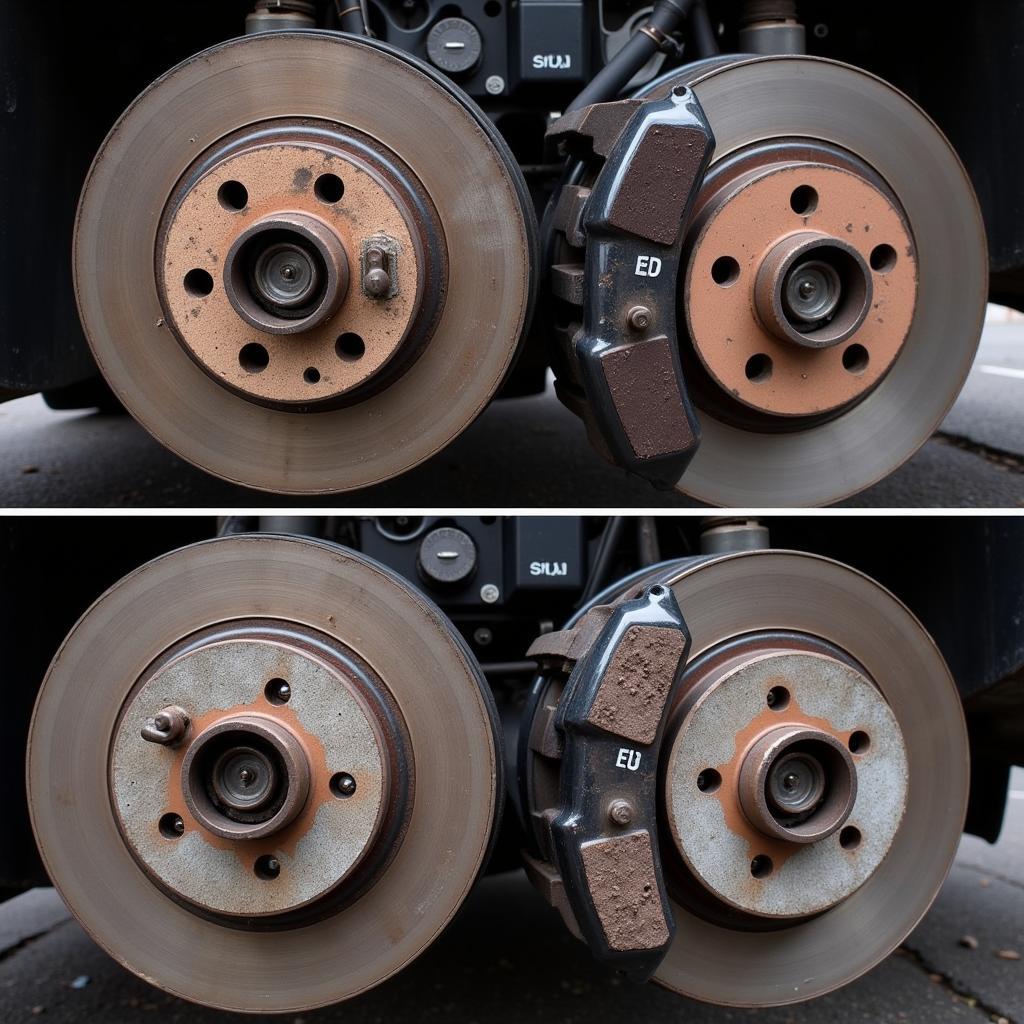The 2003 Hyundai Santa Fe brake warning light can be a source of anxiety for drivers. Understanding what triggers this light and how to address the underlying issue is crucial for maintaining safety and preventing further damage. This comprehensive guide dives into the common causes of the brake warning light in a 2003 Hyundai Santa Fe, providing troubleshooting steps and potential solutions.
Understanding the Brake Warning Light
The brake warning light on your 2003 Hyundai Santa Fe serves a dual purpose: it alerts you to a potential issue with your braking system, and it also functions as the parking brake indicator. If the light illuminates while driving with the parking brake disengaged, it signals a problem requiring immediate attention. Ignoring this warning can lead to costly repairs and compromise your safety on the road.
Common Causes of a 2003 Hyundai Santa Fe Brake Warning Light
Several factors can trigger the brake warning light. Identifying the specific cause requires systematic troubleshooting. Here are some of the most common culprits:
- Low Brake Fluid: This is the most frequent cause. A leak in the brake lines, worn brake pads, or a failing master cylinder can deplete brake fluid levels.
- Worn Brake Pads: Brake pads wear down over time. Thin pads activate a sensor that illuminates the warning light.
- Faulty Brake Sensor: Sometimes, the sensor itself can malfunction, triggering the light even if the brake pads are in good condition.
- Parking Brake Issues: A partially engaged parking brake or a malfunctioning parking brake switch can keep the light illuminated.
- ABS Problems: While a separate ABS light usually indicates issues with the Anti-lock Braking System, a problem with the ABS system can sometimes trigger the brake warning light as well.
- Master Cylinder Problems: The master cylinder is the heart of your braking system. A failing master cylinder can lead to low brake fluid and trigger the warning light.
Troubleshooting the Brake Warning Light
Before rushing to a mechanic, you can perform some basic troubleshooting steps yourself.
- Check the Parking Brake: Ensure the parking brake is fully released. Sometimes, a slight engagement can trigger the light.
- Inspect Brake Fluid Level: Open the hood and locate the brake fluid reservoir. Check the fluid level. If it’s low, add brake fluid that meets the manufacturer’s specifications.
- Visually Inspect Brake Pads: If possible, take a look at the brake pads through the wheel spokes. If they appear excessively thin, they likely need replacement.
 Worn brake pads on a 2003 Hyundai Santa Fe
Worn brake pads on a 2003 Hyundai Santa Fe
What if the Light Stays On?
If the light persists after these checks, further diagnosis is necessary. This may involve checking the brake lines for leaks, testing the brake sensors, and inspecting the master cylinder.
“Regular brake system maintenance is key to avoiding unexpected issues. Checking your brake fluid and having your brakes inspected regularly can save you from costly repairs down the line.” – David Miller, Automotive Service Excellence Master Technician
Solutions and Repairs
Depending on the diagnosed cause, solutions can range from simple fixes to more involved repairs.
- Adding Brake Fluid: If the fluid is low, topping it off may resolve the issue. However, persistent low fluid indicates a leak that requires professional attention.
- Replacing Brake Pads: Worn brake pads need replacement. This is a standard maintenance procedure.
- Replacing Brake Sensors: A faulty sensor needs replacement.
- Repairing or Replacing the Master Cylinder: A failing master cylinder requires repair or replacement, depending on the severity of the issue.
“Ignoring the brake warning light can be dangerous. It’s crucial to address the underlying problem promptly to ensure your safety and prevent further damage to the braking system.” – Sarah Chen, Certified Automotive Technician
Conclusion
The 2003 Hyundai Santa Fe brake warning light serves as a vital safety indicator. Addressing the underlying issue promptly is crucial. By understanding the potential causes and utilizing the troubleshooting steps outlined in this guide, you can effectively address the problem and ensure the safety and reliability of your vehicle. Don’t hesitate to consult a qualified mechanic for further diagnosis and repairs if needed.
FAQ
-
How often should I check my brake fluid? It’s recommended to check your brake fluid level at least once a month.
-
How long do brake pads typically last? Brake pad lifespan varies depending on driving habits and conditions, typically ranging from 25,000 to 70,000 miles.
-
Can I drive with the brake warning light on? While it might be possible to drive a short distance, it’s strongly advised against driving with the brake warning light on.
-
Is it expensive to fix a brake problem? The cost of brake repairs depends on the specific issue. Simple fixes like adding brake fluid are inexpensive, while more complex repairs like replacing a master cylinder can be more costly.
-
What should I do if my brake pedal feels spongy? A spongy brake pedal is often a sign of air in the brake lines. This requires professional bleeding of the brake system.
-
How can I prevent brake problems? Regular brake inspections and maintenance, along with mindful driving habits, can help prevent many brake problems.
-
What does the ABS light mean? The ABS light indicates a problem with the Anti-lock Braking System. While it’s a separate system, it can sometimes be related to the brake warning light.

